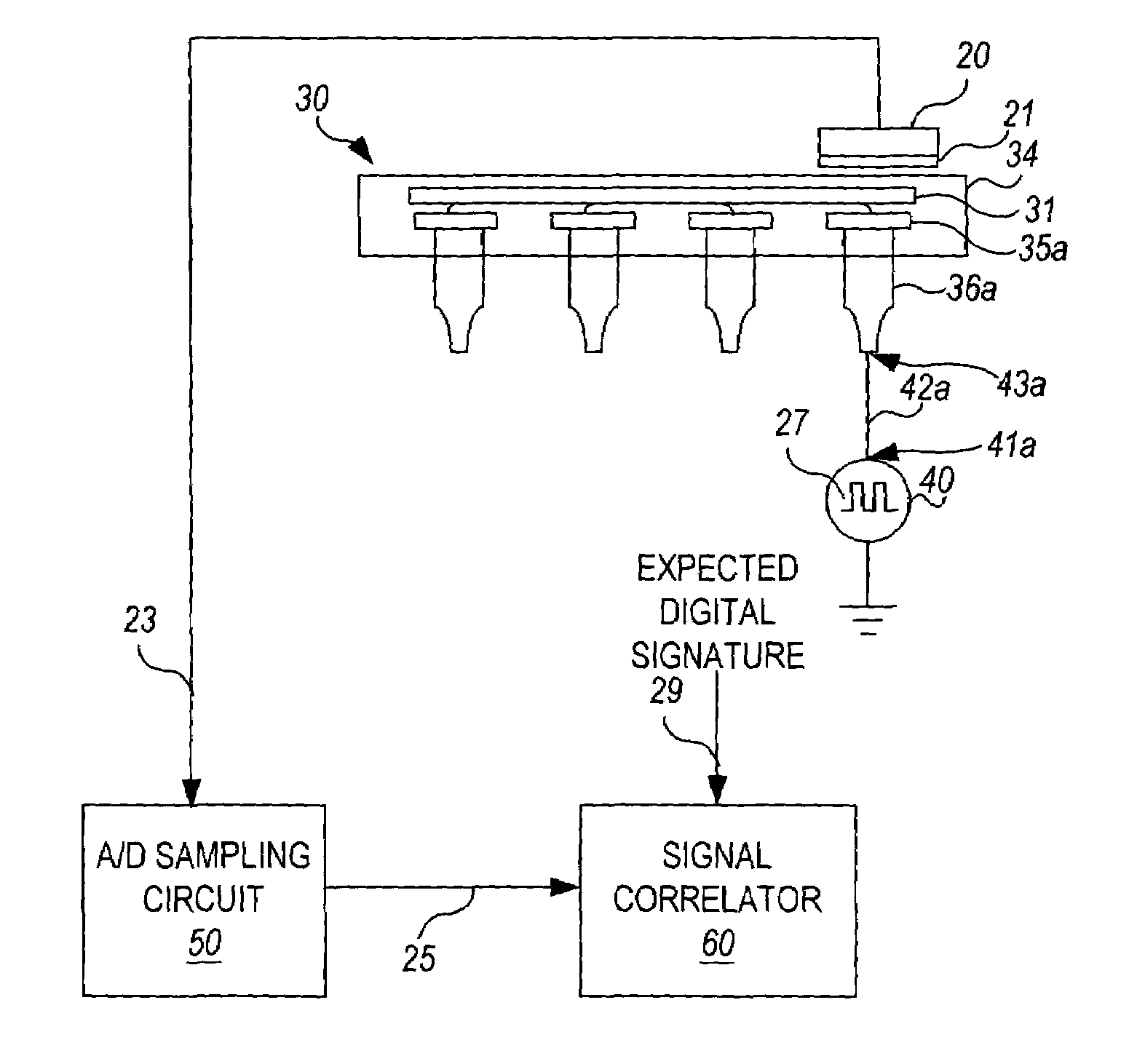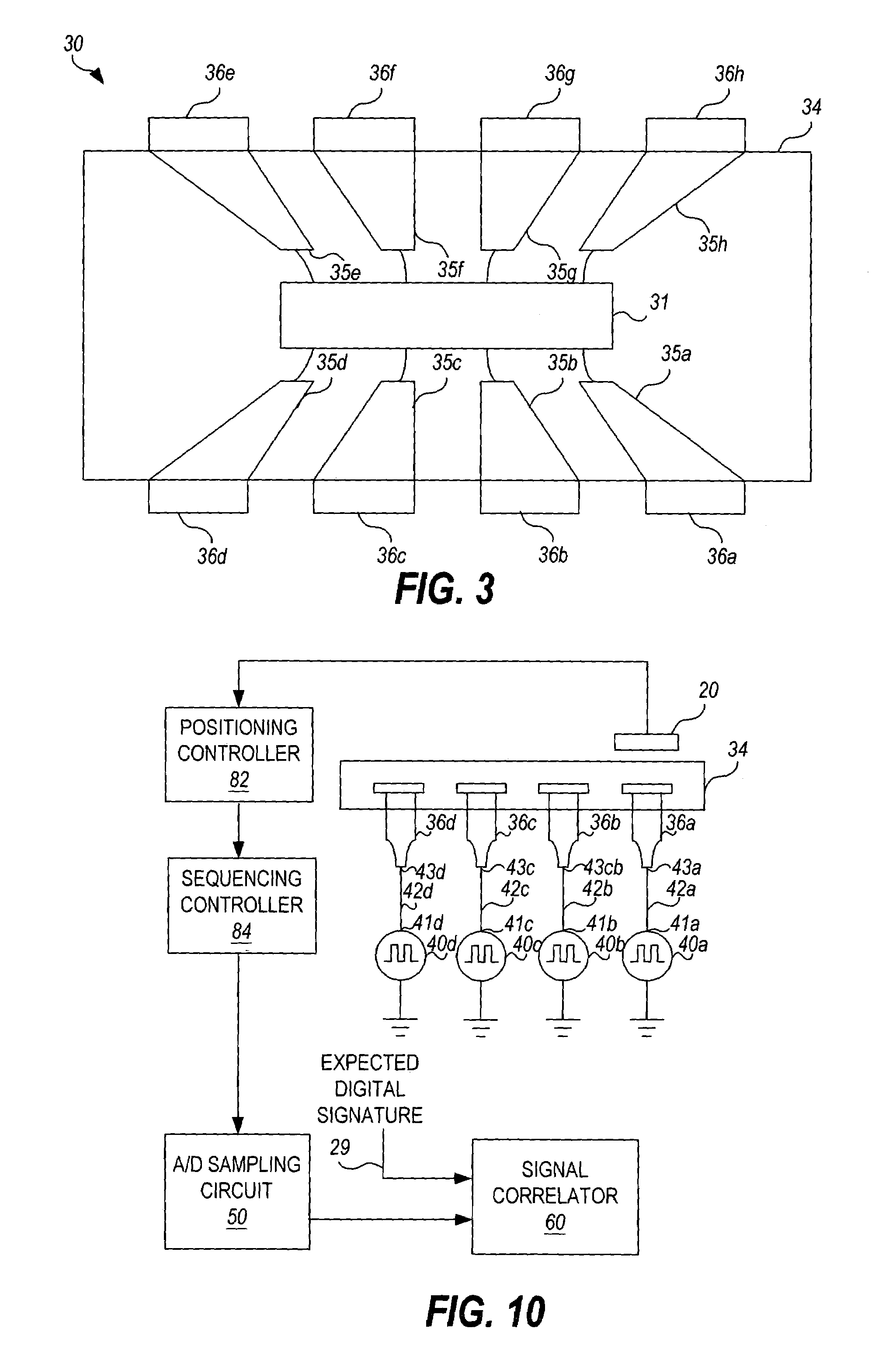Capacitive sensor measurement method for discrete time sampled system for in-circuit test
a sensor measurement and in-circuit test technology, applied in the direction of electronic circuit testing, measurement devices, instruments, etc., can solve the problems of ac reference source limitation, open circuits are common defects in the manufacture of pcb assemblies, and the configuration and settling time of relays can take a significant amount of tim
- Summary
- Abstract
- Description
- Claims
- Application Information
AI Technical Summary
Benefits of technology
Problems solved by technology
Method used
Image
Examples
first embodiment
[0036]Turning now to the invention, FIG. 2 is a schematic block diagram of a test configuration for acquiring capacitively sensed measurements implemented according to the invention. In this configuration, a capacitive sensing probe 20 comprising a metallic electrode 21 is placed on top of the package 34 of an integrated circuit chip 30. A net 42a (which may be a wire, a trace, a solder bump, or any other known conductive material, and / or combination thereof) is characterized by a first end 41a connected to the output of an oscillating digital source 40 and a second end 43a connected to a pin 36a of the integrated circuit chip 30.
[0037]Digital square-wave source 40 generates a reference signal (or “stimulus”) 27. Analog-to-digital (A / D) sampling circuit 50 is connected to receive a capacitively coupled signal 23 sensed by probe 20. The sampling circuit 50 samples at least two times (2×) the frequency of the reference signal 27. In the preferred embodiment, the sampling rate is ten t...
second embodiment
[0051]FIG. 10 is a schematic block diagram of a second embodiment test configuration for acquiring multiple capacitive sensor measurements implemented according to the invention. In this configuration, multiple nets 45a, 45b, 45c, 45d of interest are tested. In the example shown, each net 45a, 45b, 45c, 45d (which may be a wire, a trace, a solder bump, or any other known conductive material, and / or combination thereof) is characterized by a first end 41a, 41a, 41b, 41c, 41d connected to the output of a respective oscillating digital source 40a, 40b, 40c, 40d, and a second end 43a, 43b, 43c, 43d connected to a respective integrated circuit pin 36a, 36b, 36c, 36d.
[0052]In the embodiment of FIG. 10, the area of the metallic electrode plate 21 of the capacitive sensing probe 20 is sized to cover only a portion of the conductor 35a, 35b, 35c, 35d, 35e, 35f, 35g, 35h connected to a single pin 36a, 36b, 36c, 36d, 36e, 36f, 36g, 36h of the integrated circuit package 34.
[0053]FIG. 11 shows ...
third embodiment
[0054]FIG. 12 is a schematic block diagram of a third embodiment test configuration for acquiring multiple capacitive sensor measurements implemented according to the invention. In this configuration, multiple nets 42a–42h of interest are tested. In the example shown, each net 42a–42h (which may be a wire, a trace, a solder bump, or any other known conductive material, and / or combination thereof) is characterized by a first end 41a–41h respectively connected to the output of a respective oscillating digital source 40a–40h, and a second end 43a–43h respectively connected to a respective integrated circuit pin 36a–36h.
[0055]FIG. 13 shows a top cutaway view of the integrated circuit chip 30 and capacitive sensing probes 20a–20h of FIG. 12 (indicated by dashed lines). As illustrated, a different respective capacitive sensing probe 20a, 20b, 20c, 20d, 20e, 20f, 20g, 20h is respectively aligned over a different respective internal lead conductor 35a, 35b, 35c, 35d, 35e, 35f, 35g, 35h of ...
PUM
 Login to View More
Login to View More Abstract
Description
Claims
Application Information
 Login to View More
Login to View More - R&D
- Intellectual Property
- Life Sciences
- Materials
- Tech Scout
- Unparalleled Data Quality
- Higher Quality Content
- 60% Fewer Hallucinations
Browse by: Latest US Patents, China's latest patents, Technical Efficacy Thesaurus, Application Domain, Technology Topic, Popular Technical Reports.
© 2025 PatSnap. All rights reserved.Legal|Privacy policy|Modern Slavery Act Transparency Statement|Sitemap|About US| Contact US: help@patsnap.com



